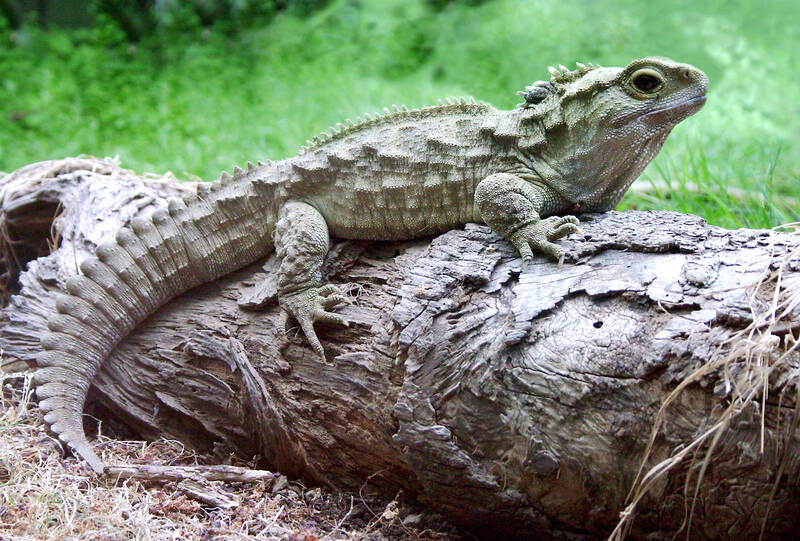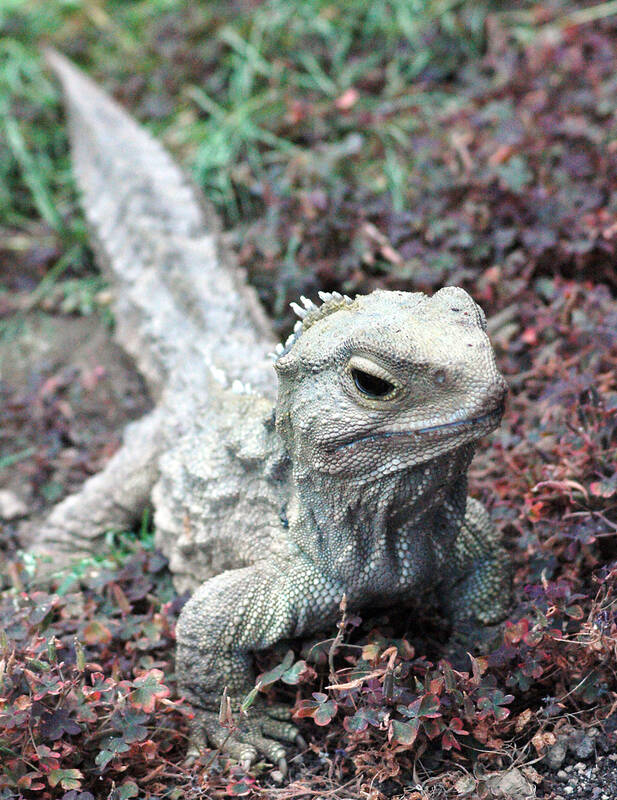About 130 years ago — as New Zealand women celebrated their world-first right to vote, athletes competed in the first international Olympic Games, and the first motion pictures were flickering into view — a tiny mottled green reptile with a spiny back was hatching on a small New Zealand island.
The baby tuatara — a unique and rare reptile endemic to New Zealand — emerged from his burrow into the forest floor, where he miraculously evaded birds, rats and cannibalistic adult tuatara to reach his full adult size — nearly one kilo in weight and half a meter in length — by the time he was 35.
Over the next few decades, he fossicked about Stephens Island at the northern tip of the South Island, hunting by night and sunning himself by day. Then, at roughly 80 years old, his time in the wild ended. In 1970, he was transported to a museum in Invercargill, the country’s southern-most city, to begin a new life in the public eye as “Henry the tuatara.”

Photo: EPA
Now believed to be between 110 and 130 years old, Henry is likely the world’s oldest living tuatara and New Zealand’s oldest resident. He is also the most famous and beloved of his species.
New Zealand has no native land-based snakes or turtles, and the majority of its 150 or so reptiles are lizards. But while the tuatara — New Zealand’s largest reptile — may look like a lizard, it is not one. Rather, it is the sole survivor of the ancient reptile order Sphenodontia, which walked the Earth with dinosaurs 225 million years ago.
They are considered a taonga (treasured) species for Maori and hold a special place in the hearts of New Zealanders, appearing on coins, stamps and in children’s books and cartoons.

Photo courtesy of Wikimedia Commons
The reptiles have also long fascinated scientists — they have a parietal or “third” eye on the top of their head which detects light. They are one of the slowest growing reptiles in the world, while boasting the fastest swimming sperm of any reptiles studied to date.
They can take 16 months to hatch, reproduce past the age of 100 and live up to 200 years, making them one of the longest-living creatures. Once widespread across New Zealand, tuatara now survive primarily on a scattering of offshore islands where introduced predators have been eliminated.
Some, such as Henry, live in state-of-the-art digs, where their environment, diet and health is closely monitored.
AN AUDIENCE WITH HENRY
Caroline Dawson, a living-species officer with the Invercargill city council, treads carefully between mossy logs and plants inside a new open-air tuatara enclosure in Invercargill’s Queens Park animal reserve. The council-built facility replicates a natural living environment for tuatara and is the only one of its kind in New Zealand.
“We have to be really careful where we stand, some tuatara like to live in the logs,” Dawson warns.
She lifts a large concrete lid covering a man-made burrow. Inside is a tuatara but it is not Henry. This one is Lucy, a smaller 70-year-old female — one of Henry’s two live-in girlfriends.
“When I first started working with tuatara I thought ‘these guys are so boring,’” Dawson says, heaving open the lid of another burrow, which is empty.
“And then I fed one,” she says. “Wow, they are so quick — they are like killing machines.”
Dawson lifts the last lid in Henry’s enclosure and peers in.
“There he is, there’s the man,” she says, brimming with excitement.
Henry, unperturbed by the intrusion, is lying still next to Mildred, his other septuagenarian girlfriend. During cooler months, tuatara are slow-moving and rarely eat; come summer, they venture out to hunt and sunbathe.
Gently, Dawson picks him up and places him on a nearby log.
“Isn’t he amazing?” she says, and he is.
The ancient reptile’s skin is the colors of a dappled forest floor. From the top of his wide strong head to the tip of his tail runs a line of pearly spikes. His big black eyes are as glossy as obsidian and, with his head poised high, he looks as royal as his monarch namesake, Henry VIII.
Henry grants his visitors a brief audience, and with the late-afternoon sun slipping behind the trees and the air cooling, he decides it is time to return to his warm burrow.
Henry has not always been so amenable — for 17 years, he was so irascible he had to be completely isolated from other tuatara. Sex, meanwhile, was of little interest to him — when handlers tried to mate him with Mildred 40 years ago, he twice bit off her tail.
In 2007, the removal of a cancerous tumor on his genitals changed all that — including his personality and his libido — and the following year, Henry made international headlines when he became a first-time father, aged 111.
During his long life, Henry has clocked up a list of headline-grabbing experiences, including meeting Prince Harry in 2015, starring in an award-winning documentary and holding the world record for living in captivity for over 46 years.
In June — after a year hidden from public view — Henry and another 16 tuatara were moved into their new enclosure. Henry’s housewarming — a public celebration of his new digs — attracted 2,000 people, who lined up for hours to glimpse him.
Dawson bids Henry goodnight and locks the enclosure’s door behind her.
“Everybody loves tuatara and everybody loves Henry,” Dawson says. “[He’s] magnificent, he is an icon.”

The canonical shot of an East Asian city is a night skyline studded with towering apartment and office buildings, bright with neon and plastic signage, a landscape of energy and modernity. Another classic image is the same city seen from above, in which identical apartment towers march across the city, spilling out over nearby geography, like stylized soldiers colonizing new territory in a board game. Densely populated dynamic conurbations of money, technological innovation and convenience, it is hard to see the cities of East Asia as what they truly are: necropolises. Why is this? The East Asian development model, with

June 16 to June 22 The following flyer appeared on the streets of Hsinchu on June 12, 1895: “Taipei has already fallen to the Japanese barbarians, who have brought great misery to our land and people. We heard that the Japanese occupiers will tax our gardens, our houses, our bodies, and even our chickens, dogs, cows and pigs. They wear their hair wild, carve their teeth, tattoo their foreheads, wear strange clothes and speak a strange language. How can we be ruled by such people?” Posted by civilian militia leader Wu Tang-hsing (吳湯興), it was a call to arms to retake

This is a deeply unsettling period in Taiwan. Uncertainties are everywhere while everyone waits for a small army of other shoes to drop on nearly every front. During challenging times, interesting political changes can happen, yet all three major political parties are beset with scandals, strife and self-inflicted wounds. As the ruling party, the Democratic Progressive Party (DPP) is held accountable for not only the challenges to the party, but also the nation. Taiwan is geopolitically and economically under threat. Domestically, the administration is under siege by the opposition-controlled legislature and growing discontent with what opponents characterize as arrogant, autocratic

When Lisa, 20, laces into her ultra-high heels for her shift at a strip club in Ukraine’s Kharkiv, she knows that aside from dancing, she will have to comfort traumatized soldiers. Since Russia’s 2022 invasion, exhausted troops are the main clientele of the Flash Dancers club in the center of the northeastern city, just 20 kilometers from Russian forces. For some customers, it provides an “escape” from the war, said Valerya Zavatska — a 25-year-old law graduate who runs the club with her mother, an ex-dancer. But many are not there just for the show. They “want to talk about what hurts,” she